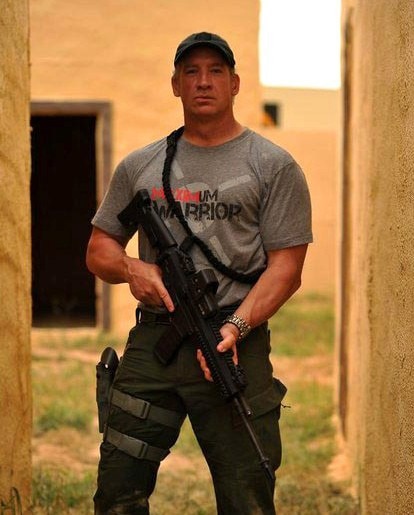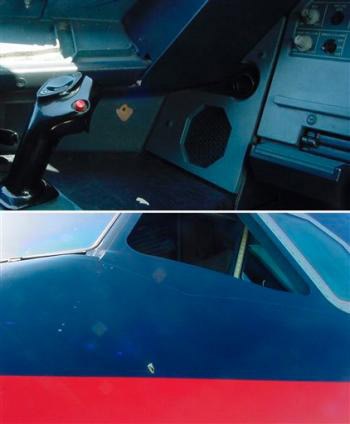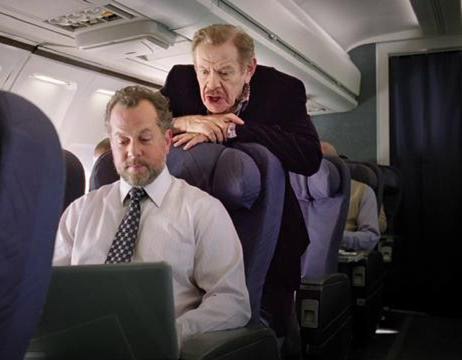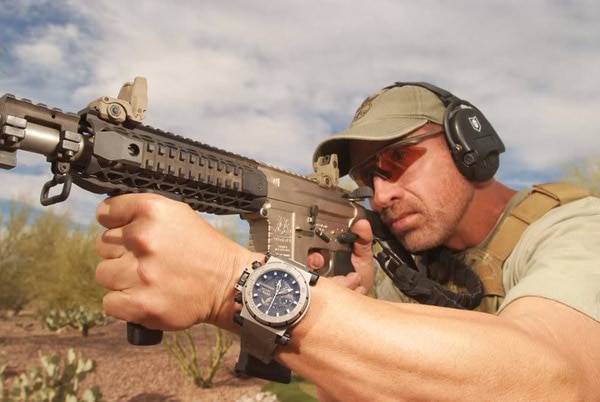This post originally ran on Guns.com on September 11, 2012 as ‘Rembering 9/11 (with two Federal Air Marshals)’.
Craig Sawyer, a former U.S. Navy SEAL assigned to the crème de la crème of one of the most elite and highly classified military units in the world—the United States Naval Special Warfare Development Group, or simply, DEVGRU—was one of only 33 undercover FAMs prior to September 11, 2001. If the question is who can sneak a gun onto a plane without ever getting caught the answer is Craig “Sawman” Sawyer (or as we’ll see, at least it used to be).
 I had a chance to catch up with the Sawman last year in between appointments, interviews and auditions in Los Angeles, California, where a man of his unique background, skill and talent is bound to make him an incredible asset to Hollywood. In fact, he’s already been serving as a tactical adviser and shooting instructor for Top Shot, the television hit series among firearms aficionados. Since it’s been over ten years since one of the worst days in U.S. history—September 11, 2001—Sawyer and I revisited the topics of aviation security, terrorism, and of course, guns on planes (having served as an undercover air marshal myself, you could say I have a view from inside as well).
I had a chance to catch up with the Sawman last year in between appointments, interviews and auditions in Los Angeles, California, where a man of his unique background, skill and talent is bound to make him an incredible asset to Hollywood. In fact, he’s already been serving as a tactical adviser and shooting instructor for Top Shot, the television hit series among firearms aficionados. Since it’s been over ten years since one of the worst days in U.S. history—September 11, 2001—Sawyer and I revisited the topics of aviation security, terrorism, and of course, guns on planes (having served as an undercover air marshal myself, you could say I have a view from inside as well).
On that fateful day in September when nearly 4,000 people lost their lives, there were only 33 Federal Air Marshals (including Sawyer) covering approximately 25,000 daily flights. Unfortunately, the odds of stopping 19 hijackers on just four planes favored the terrorists. Since those days, a lot has been written and speculated about the covert FAMs, their tactics, their guns and their numbers (which is classified), with some of the most damaging information coming from the government itself, who gave away much of the FAMs tactical playbook, free, to any would-be terrorists to peruse, in the years after the World Trade Center fell.
Many current and former plain clothes, air sentries were furious over the infatuation FAMS management seemed to have with the media in the wake of the 9/11 attacks; things that should have been kept secret were openly discussed and information disseminated from the TSA/FAMS headquarters that put officers at risk. The award-winning documentary film, Please Remove Your Shoes outlines the TSA (Transportation Security Administration) and FAMS disasters perfectly so all I will say on the subject is that in time, whistleblowers and tactical specialists, like Sawyer, decided to speak up with many FAMs leaving the agency.
Below are just a few tactical shockers Sawyer and I reflected on.
The Gun
When it comes to pistols, air marshals have been called some of the best shooters in law enforcement. Missing your target on a crowded and compact plane is simply not an option, but to many officers in the field, neither was releasing the exact make and caliber of handgun undercover officers would be carrying.

Within weeks of the September attacks, the government released the type and model handgun their “undercover air marshals” carried: the Sig Sauer P229 DA/SA. Additionally, a public announcement was made saying that Sig Sauer won another multi-million dollar contract, and that the Federal Air Marshal Service would soon be switching to the new P250. Air marshals, like Sawyer, hoping to remain discreet and win in the event of another terrorist attack, were furious their own supervisors were telling terrorists what to practice with. With this information, terrorists knew they could overpower one or two air marshals and then use their weapon to take over the flight. Why go through all the trouble of smuggling a gun past airport security, when it’s already waiting on the plane for you?
The Ammo
Regarding ammunition, the media was told by FAMS headquarters that undercover air marshals carried the .357 Sig round—quite a hot load for a very crowded plane.
 Despite what some may believe (likely based on a few frightening movie scenes) it’s a myth that depressurization could be caused by one tiny bullet hole in the skin of the aircraft. The plane wouldn’t be ripped apart, but that still doesn’t mean there isn’t lot of collateral damage associated with firing a gun on a plane. Hitting innocent passengers because of over penetration (hopefully not because of a missed shot), shooting hydraulic lines or important electrical wiring could cause just as much of a problem as would say a stray round going through the flight deck door and hitting a pilot.
Despite what some may believe (likely based on a few frightening movie scenes) it’s a myth that depressurization could be caused by one tiny bullet hole in the skin of the aircraft. The plane wouldn’t be ripped apart, but that still doesn’t mean there isn’t lot of collateral damage associated with firing a gun on a plane. Hitting innocent passengers because of over penetration (hopefully not because of a missed shot), shooting hydraulic lines or important electrical wiring could cause just as much of a problem as would say a stray round going through the flight deck door and hitting a pilot.
One would think that reduced ricochet limited penetration rounds on airplanes would do well. They did. Sawyer told me they used to carry a 9mm as air marshals, with a standard hollow point tip. Then, without coordination or consensus, a single manager working in the FAMS training department, implemented the transition to the .357 Sig round, following the pathway of the U.S. Secret Service weapon. Suggestions to changeover to a more practical—and tactical—round for use on board an airplane in flight were ignored. When 9/11 occurred, the concrete of one man’s untested decision regarding new ammo had dried.
On Dec. 7, 2005, air marshals justifiably shot and killed American Airlines passenger Rigoberto Alpizar in a Miami jet way after he claimed he had a bomb. Fortunately for those brave officers, no other people were directly behind the suspect. If they had been, they would have been shot.
The Tactics
From mandatory grooming and dress standards to dangerous, mandated procedures that did not address real world scenarios, rigid and arbitrary policies squashed much of the individual tactical prowess air marshals brought with them to the TSA. Two FAM sanctioned news specials made sure that everyone and their mother knew this.
On Feb. 5 and 6, 2004, NBC Nightly News did a lengthy, in-depth report on the FAMS, under the direction of FAMS headquarters. The two-piece segment, titled “A Day in the Life of a Federal Air Marshal,” divulged the number of FAMs that fly on missions and that marshals wear “business attire,” and have a “professional appearance.” It showed how FAMs present credentials to airline personnel and other very sensitive data. The camera crew was allowed to film on the plane. Footage showed where the marshal was sitting on that particular flight, what he was wearing, the government-issued digital device he held, and even his face. The narrator said (paraphrased only slightly if at all), “Air Marshals usually fly in pairs, but on this particular flight, two Air Marshals [including the one on camera] are sitting up front and one is in the back.”
 In November 2004, the Miami Special Agent in Charge (SAC), Jim Bauer, invited WSVN News in Florida to interview him at the Miami Field Office. A three-piece segment aired. There, in a mock airplane inside the office, he had two air marshals, not wearing masks, demonstrate what may have been at the time the entire tactical standard operating procedure for all Federal Air Marshals from beginning to end. The video and audio news release explicitly detailed information showing the step-by-step process on how FAMs deploy and activate to recover a plane during a hijacking. Terrorists didn’t even need to have basic cable to know how the FAMs operate.
In November 2004, the Miami Special Agent in Charge (SAC), Jim Bauer, invited WSVN News in Florida to interview him at the Miami Field Office. A three-piece segment aired. There, in a mock airplane inside the office, he had two air marshals, not wearing masks, demonstrate what may have been at the time the entire tactical standard operating procedure for all Federal Air Marshals from beginning to end. The video and audio news release explicitly detailed information showing the step-by-step process on how FAMs deploy and activate to recover a plane during a hijacking. Terrorists didn’t even need to have basic cable to know how the FAMs operate.
Suffice it to say at 30,000 feet on a crowded plane, often with no backup, FAMs have to be tactical experts. That’s why Sawyer was there. Nevertheless, training on the range, in the gym or in the simulator didn’t do much good when FAMs lost the element of surprise; as mentioned at the beginning of this article, Sawyer found now he wasn’t always able to sneak on board an airplane without telegraphing his weapon or being singled out by someone as an air marshal.
It was at this point in this career that Sawyer had about all he could stand as he witnessed—and personally experienced—abuses and foolish mismanagement. Seeing the writing on the wall (the one that read: “Hey everybody, the air marshal is right there!”) Craig Sawyer turned in his badge and his gun after serving his country for 18 years in 2004. He still quietly serves to this day on a classified project.
Common Sense
Looking to counter-terrorism on a scale larger than only aviation security, Sawyer told me his feelings regarding the socio-political climate. “We don’t have a national resolve to get it right. We have to fully intend to be effective. We have to do what works.”
Small changes have occurred here and there—at least within the FAMS leadership and certain policies and procedures. Still, whether on a plane or charged with countering terrorism in one way or another, Sawyer says we still have a lot to learn. “The biggest weapon against the United States is political correctness,” he said, and added, “It prevents common sense.”
 Having visited or operated in over 50 countries, the special operations veteran has seen what works and what doesn’t when it comes to combat, both inside and outside the continental United States.’
Having visited or operated in over 50 countries, the special operations veteran has seen what works and what doesn’t when it comes to combat, both inside and outside the continental United States.’
“We have much to learn from Israel when it comes to national security. They’re small, surrounded by their enemies and have a real and pressing threat every day. They have to get it right. You don’t see political correctness there. They can’t afford such pretense. They must do what actually works.”
Prior to my time as an undercover FAM, I worked and lived in Israel as a contractor with the U.S. Department of State. It was refreshing to hear Sawyer bring up the Israelis.
Today, Sawyer continues his enthusiasm eradicating both terrorists and terrorism, and when it comes to guns, tactics and getting things right, Craig “Sawman” Sawyer, remains one man full of common sense. He wouldn’t have so many successes, without it.
The post Remembering 9/11 on 9/11 (with two Federal Air Marshals) appeared first on Guns.com.
